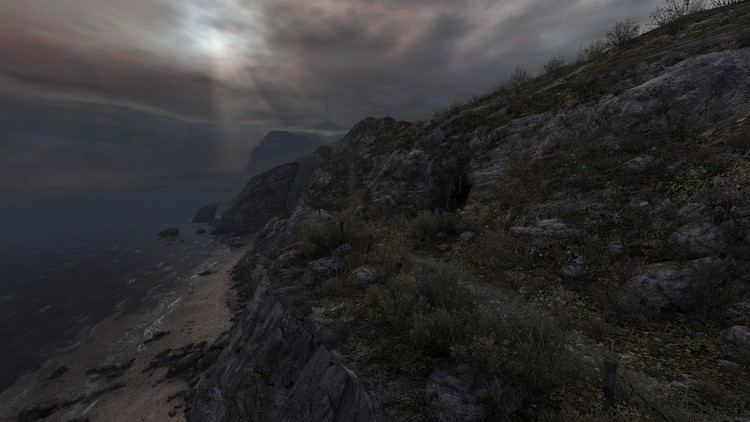7.2 /10 1 Votes7.2
8/10 IGN Distributor(s) Steam Programmer(s) Jack Morgan Writer(s) Dan Pinchbeck Initial release date 14 February 2012 Genres Adventure game, Art game | 7/10 Steam 68% Metacritic Producer(s) Dan Pinchbeck Artist(s) Robert Briscoe Composer(s) Jessica Curry | |||||||||||||||||||||||||||||||||
 | ||||||||||||||||||||||||||||||||||
Nominations BAFTA Games Award for British Game Similar The Chinese Room games, Adventure games | ||||||||||||||||||||||||||||||||||
Ign reviews dear esther game review
Dear Esther is a first-person video game developed by Thechineseroom for Microsoft Windows, Mac OS X, and Linux. First released in 2008 as a free-to-play modification for the Source game engine, the game was entirely redeveloped for a commercial release in 2012. Spurning traditional game design, Dear Esther features virtually no puzzles or tasks. The player's only objective is to explore an unnamed island in the Hebrides, listening to a troubled man read a series of letters to his deceased wife. Details of her mysterious death are revealed as the player moves throughout the island.
Contents
- Ign reviews dear esther game review
- Dear esther official trailer
- Gameplay and plot
- Development
- Original
- Re release
- References

While some reviewers challenged the status of Dear Esther as a video game, citing the minimal gameplay as a step away from convention, it received a generally positive critical reception. The game was released for the PlayStation 4 and Xbox One on 20 September 2016 and re-released for PC/Mac 14 February 2017 under the name "Dear Esther: Landmark Edition".

A spiritual successor, titled Everybody's Gone to the Rapture, was released for PlayStation 4 in August 2015 and for Microsoft Windows in April 2016.

Dear esther official trailer
Gameplay and plot

The "gameplay" in Dear Esther is minimal, the only object being to explore an uninhabited Hebridean island, listening to an anonymous man read a series of letter fragments to a woman named Esther. The letters suggest that Esther was his wife and that she is dead, killed in a car crash. As the player reaches a new location on the island, the game plays a new letter fragment relating to that area. Different fragments are played in each playthrough of the game, revealing different aspects of the story each time. Several other unseen characters are referred to by the narrator: a man named Donnelly, who charted the island in the past; Paul, who is suggested to be the drunk driver in the accident in which Esther died; and a shepherd named Jakobson who lived on the island in the 18th century. As the player explores the island, they find the derelict remains of buildings, a shipwreck, and a cave system whose walls are adorned with images resembling chemical diagrams, circuit diagrams, neurons and bacteria. At various points a figure is seen walking away from the player in the distance, but disappears before they can be reached. The identities of the characters become more blurred as the game progresses, as the narration moves between topics and relates the characters in different ways. The ambiguity of the randomly played letter fragments forces the player to draw their own conclusions of the story.

At the game's end, the player reaches the radio mast atop the island's peak and climbs a ladder to the top of the tower during a final monologue by the narrator. As the player jumps off and falls to the shore below, their shadow becomes that of a bird. The player soars through the island's bay before flying low over an array of paper boats in the water—the many letters the narrator had written to Esther.
Development

The original rendition of Dear Esther was one of several modifications (mods) developed by The Chinese Room while the studio was still a research project at the University of Portsmouth. The project was funded by a grant from the Arts and Humanities Research Council and led by Dan Pinchbeck, a professor and lecturer at the university. The story and script were composed by Pinchbeck, who cited the works of William S. Burroughs as influential in the writing: "Burroughs worked structurally [as] a big influence, but also I was really interested in moving towards a quite image-heavy, symbolic, poetic use of language rather than the normal descriptive tone we find in games."
Independent games artist Robert Briscoe began work on completely redeveloping Dear Esther in 2009, with the full support of Pinchbeck. Briscoe and The Chinese Room worked in parallel on the game's remake, with much of the level design completed solely by Briscoe based on concept art done by Ben Andrews. In redesigning the island's landcape, Briscoe aimed to eliminate the confusion caused by the original game's lay-out, and to fill out the environment with "richer, visually interesting" features to improve on the barren landscape of the original mod. In March 2011, while the game was still in development, The Chinese Room lost the financial backing of the University it had hitherto relied on. The studio had banked on the University to pay for the Source Engine license needed for a commercial release of the game, but the University's legal department was dissatisfied with the license agreement and refused to sign it. The Chinese Room turned to the Indie Fund for finances, who were hesitant at first but after playing a demo, agreed to fund the project. The Fund's Ron Carmel stated "As soon as people started playing it, the tone of the conversation just completely shifted, and people were very much in favor of supporting this project". Within six hours of the remastered release on Steam, over 16,000 units had been sold, allowing the developers to pay back the full Indie Fund investment.
Robert Briscoe announced in a blog post, on 14 February 2014, that he had begun porting Dear Esther to the Unity Engine two months prior to this announcement. He has cited an abandoned native Linux port, escalating bugs in the Mac OS X port, spiraling additional licensing costs of the Source Engine to be some of the reasons behind the move to the Unity Engine. Development plans include "a solid, high quality, Linux and Mac build, and then eventually PC" and beta releases for existing Humble Store and Humble Bundle customers to evaluate and test. He also mentions that the development is still experimental and that there will not be any Steam or other build replacements until the team are satisfied with the quality of this port. In another blog post, on 11 March 2014, announcing his employment with Valve Corporation, Robert also mentions that the bulk of the port has been completed, with just a little of the back-end and scripting development remaining and that he should be able to finish the port in his spare time with ease.
The voice of Dear Esther's narrator was performed by Nigel Carrington, whose script was extended for the remake. The game's music was composed by Jessica Curry, a freelance music composer and co-director of The Chinese Room. In the remake's development, Curry overhauled and re-orchestrated the score to be fuller and longer, featuring more instruments and reaching nearly double the length of the original soundtrack. The music of the original game was released for free on 8 July 2008, shortly after the mod itself was released, and the remastered soundtrack was released on 14 February 2012, via Amazon.com, iTunes, and Bandcamp.
Original
The original mod release of Dear Esther was selected for the Animation Exhibition at the 2008 Prix Ars Electronica and made the Top 100 of Mod DB's Mod of the Year 2008. In 2009, the game won the award for Best World/Story at the IndieCade Independent Game awards.
Reviewing the mod for Honest Gamers in 2009, Lewis Denby praised the game's original tone, saying that the game "taps into an emotion that few games dare to approach: unhappiness" and stated that Curry's soundtrack created "an impressively ethereal atmosphere". Despite commendations for its premise and story, the original mod release received complaints of poor level design and numerous glitches in moving about the terrain.
Re-release
The 2012 remastered Dear Esther has garnered mainly positive reviews from critics, receiving an average score of 71.29% based on 28 reviews and 75/100 based on 37 reviews on review aggregators GameRankings and Metacritic. Despite questioning whether it truly constitutes a video game, reviewers praised the game's originality and commented favourably on the emphasis on the story; IGN stated that the game "will leave you feeling edified, contemplative, and possibly even emotionally moved." Strategy Informer awarded the game 9/10, calling it "one of the most haunting and well-executed titles of this or any other generation." However, critics were divided by the suitability of the video game medium for conveying the story of Dear Esther. Maxwell McGee of GameSpot claimed that "[the] story in Dear Esther works well in video game form—possibly more than as a book or movie." McGee went further to claim that "video games allow for pacing and discovery that would be impossible to reproduce elsewhere." Reviewing for Destructoid, Allistair Pinsof claimed the opposite, stating that the game "would be better as a short film", although doubted whether "if Dear Esther were a short film, if its vague plot and predictable conclusion would be effective." Eurogamer also offered criticism of the plot, calling the writing "purple in places and wantonly obscure in ways which will draw accusations of pretentiousness", and joked that "the [game's] tendency to deploy extended car metaphors occasionally steers the writing into oncoming traffic." However, the review commended the lasting impact of the story, stating that "its two-hour long chill will remain in your bones for a long while after."
The limited interactivity between the player and the narrative in Dear Esther also divided reviewers. Pinsof stated that "[the] ironic thing is that the most pedestrian of stories can be convincing when coupled with intelligently applied interaction—something Dear Esther stubbornly stands against." PC Gamer did not find the basic gameplay to be a problem, stating that “the lack of puzzles is necessary: it’s crucial to the experience that you’re allowed to keep moving at your own pace. […] Without puzzles, the visuals and narrative are allowed to take precedence.”
The level of detail in Dear Esther's environment was given broad praise by critics. Reviewing for bit-tech, Joe Martin called the game "a graphical masterpiece", commenting that "what gives Dear Esther's visuals such a poignant edge is how masterfully it extends the sense of loneliness and isolation that's conveyed in the script". Writing for The Daily Telegraph, Tom Hoggins noted the effect of the game's more minor details, stating that "[the] broad strokes of Dear Esther's visuals are majestic, but the finer details on the landscape are the most revealing."
At the 2012 Independent Games Festival, Dear Esther received the prize for "Excellence in Visual Arts". In its 2012 Awards, Develop awarded Dear Esther the prize for "Best use of narrative". At the TIGA Games Industry Awards 2012, the game won the "Originality Award" along with the prizes for "Best Action/Adventure game", "Best Visual Design", "Best Audio Design" and "Best Debut Game". The game was nominated for five awards in the 9th British Academy Video Games Awards.
As of September 2013, the game had sold over 850,000 copies.
